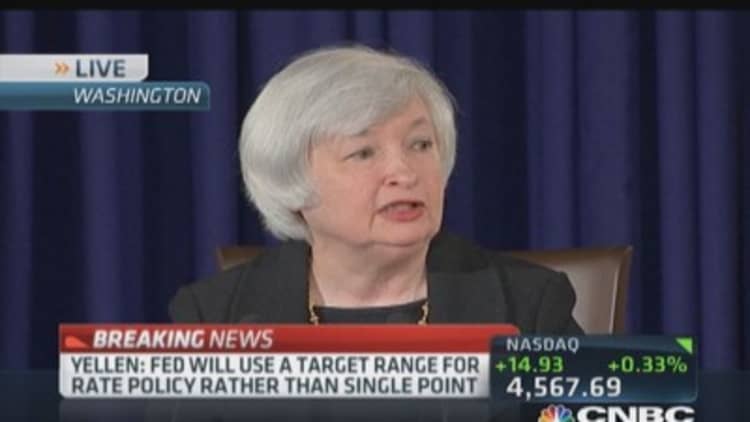Bonds sold off after traders read the Fed's new interest rate forecasts as slightly more aggressive, but dovish comments from Fed Chair Janet Yellen and the central bank's statement drove stocks higher.
The Fed retained two key pieces of language in its statement, released after its meeting Wednesday. Both a line about leaving rates low for a "considerable time" and another phrase about "significant underutilization of labor resources" were included, and both were the subject of much Wall Street speculation ahead of the meeting.
Read MoreYellen stands by 'considerable time' assessment
"Bonds, gold, the U.S. dollar all heard hawkishness. All three markets have a different interpretation than the stock market. The dollar is ripping here," said Peter Boockvar, chief market analyst at Lindsey Group. The dollar index was more than a half percent higher, while the Dow was slightly higher, pushing into record territory.
Fed officials also lowered growth forecasts for 2014 to 2016. This year's growth level fell to 2 to 2.2 percent form 2.1 to 2.3 percent, and the central tendency for GDP growth was reduced in 2015 to 2.6 to 3 percent from 3 to 3.2 percent.

The Fed sees higher growth next year, but its outlook then trails off after that. The forecast was for 2.5 to 3 percent for 2016. but that was reduced to 2.4 to 2.5 percent, and the central bank sees an even slower pace of growth in 2017—2 to 2.3 percent.
The central bank slightly changed its forecasts for rate hikes—seen as slightly more hawkish by some traders. For the end of next year, the median projections for the fed funds rate was 1.375 percent compared with 1.125 percent in June, and the projection for the end of 2016 moved up to 2.875 percent from 2.50 percent.
"Take them with a grain of salt," said Diane Swonk, chief economist at Mesirow Financial. "If you want to make a point as an outlier, that's where you make it. That's why they don't label the dots as which ones are voting and which ones aren't."
Read MoreLive Blog: Yellen stands by consdierable time
Bonds retraced slightly across the curve while Yellen spoke to the media, a half hour after the Fed statement and projections were released. "Her words were more dovish than what one might have interpreted from the FOMC statement," said David Ader, chief Treasury strategist at CRT Capital.
Yellen, during her presser, said the market's views and the Fed's views were not that far apart, in direct contrast with the findings of a recent San Francisco Fed paper that stirred up markets.
'What it's saying is they're looking at the current levels of rates, they're looking at the level of fed funds futures, and saying that's about right," said Ader. The Fed presents forecasts from each Fed official as a dot on a graph, with each representing a rate level at a point in time, and the market attempts to discern where hawkish and dovish members line up on the chart.
"The bottom line here is the language itself was fine—dovish, supportive if anything with their talk about inflation, which had been closer to their objective, now running below," said Ader. "And economic activity expanding at a moderate pace as opposed to growth rebounding. That's a little bit of a downgrade. What's doing it are the dots. The dots were more aggressive."
Bonds were mixed, with shorter duration two-year, three-year and five-year yields moving higher, but 10-year and 30-year bond yields initially moving lower. The short end is most responsive to the idea of the Fed lifting short-term rates, but the longer end moved higher as Yellen spoke.
"Why stocks are ignoring the bond market response, I don't know," said Boockvar. "This discrepancy between markets is glaring."
The Fed, for the first time, released 2017 rate forecasts, and they show high forecasts of 4 percent or more from several members. Four percent is seen as normal level for the fed funds rate, but some economists have expected the Fed to keep rates under 4 percent well into the future.
Read MoreCNBC Survey: Wall Street expects really dovish Fed on interest rates
—By CNBC's Patti Domm


